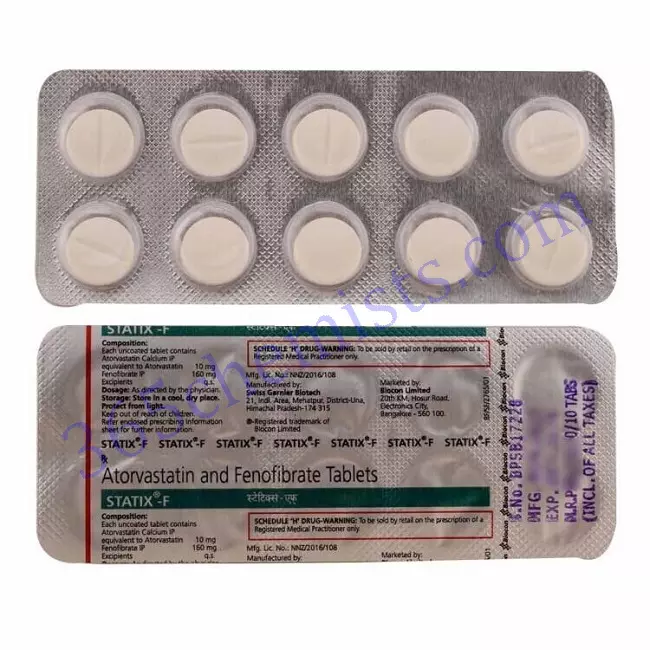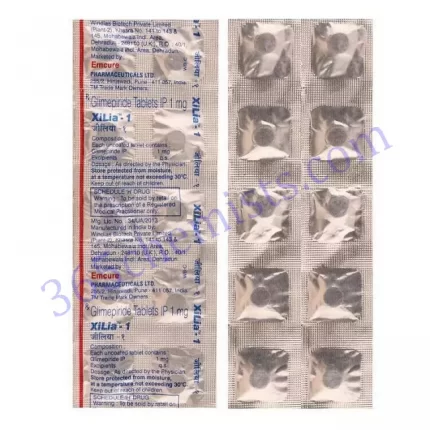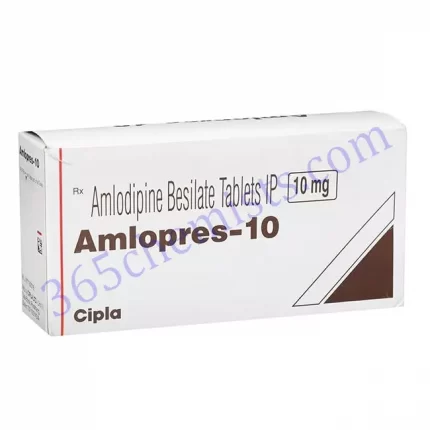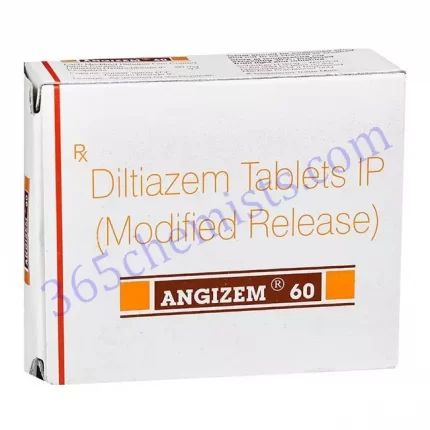Statix F Tablet (Atorvastatin 10mg/Fenofibrate 160mg):
Atorvastatin and fenofibrate are the two active components that are included in each Statix F Tablet. This medication is a combination product. The purpose of this detailed description is to provide important information about Statix F Tablet, such as its applications, recommended dosage, potential adverse effects, and other relevant details.
Uses of Statix F Tablet:
The primary application for the Statix F Tablet is the management of dyslipidemia, which refers to an abnormal condition in which there are abnormal levels of lipids in the blood. Individuals who have both high levels of low-density lipoprotein (LDL) cholesterol and high levels of triglyceride cholesterol are the target population for this medication. Statix F Tablet works to reduce levels of LDL cholesterol and triglycerides while simultaneously raising levels of high-density lipoprotein (HDL) cholesterol. This is accomplished by combining the effects of the medications atorvastatin and fenofibrate. This all-encompassing management of lipids can help reduce the risk of cardiovascular diseases like heart attack and stroke.
Dosage and Administration:
It is possible for the recommended dosage of Statix F Tablet to change for each individual based on their lipid profile as well as their reaction to treatment. It is essential to carry out the directions laid out by the medical professional in charge of your care. One tablet should be taken orally once daily, either with or without food. This is the typical and recommended dose. It is possible to adjust the dosage depending on the levels of lipids as well as the response to treatment. During treatment with Statix F Tablet, it is typically recommended to perform routine monitoring of one’s lipid profile.
Side Effects of Statix F Tablet:
The Statix F Tablet is well tolerated by most people, but it is possible for some people to experience a variety of adverse effects. Atorvastatin is known to cause a variety of unpleasant side effects, the most common of which are headache, muscle pain, joint pain, gastrointestinal disturbances (such as stomach pain, nausea, and diarrhoea), and changes in liver function tests. Fenofibrate has been linked to a number of unpleasant side effects, including gastrointestinal distress, nausea, and abnormal liver function tests. These negative reactions to medication are typically mild and short-lived, and they have a tendency to get better as the body gets used to the treatment. Rhabdomyolysis, also known as the breakdown of muscle tissue, pancreatitis, and liver problems are among the more serious adverse reactions that have been linked to the use of Statix F Tablet. It is strongly recommended that you seek immediate medical attention in the event that any severe adverse effects manifest themselves.
Precautions and Warnings:
Before beginning treatment with Statix F Tablet, it is essential to discuss any pre-existing medical conditions, allergies, or medications that you are presently taking with your healthcare provider. It is imperative that any history of liver disease, kidney disease, gallbladder disease, or any other serious health conditions be disclosed. When treating patients who have certain conditions, such as heavy alcohol consumption or uncontrolled hypothyroidism, the Statix F Tablet should be administered with extreme caution. During treatment with StatixF Tablet, it is typically recommended to perform consistent monitoring of liver function as well as levels of creatine kinase.
Related Product
Statix 10mg Tablet
Statix 20mg Tablet
Statix 40mg Tablet
Statix F Tablet
Drug Interactions:
It is possible for Statix F Tablet to interact with other medications, which could reduce the effectiveness of those other drugs or raise the risk that they will cause adverse effects. You should let your primary care physician or your chemist know about any and all medications you are currently taking, including over-the-counter medications and herbal supplements. Certain anticoagulants, certain immunosuppressants, and certain fibric acid derivatives are examples of the types of common medications that have the potential to interact negatively with StatixF Tablet. These possible interactions will be evaluated by your healthcare provider, who will then make appropriate adjustments to your medication schedule.
Storage and Handling:
The Statix F Tablet ought to be kept in a location that is both cool and dry, away from sources of moisture and direct sunlight. It is important to keep the tablets out of the reach of both children and animals. It is essential to check the date of expiration on the medication and to refrain from using it if the date has passed. If you have any concerns or questions about how to store or handle Statix F Tablet, you should seek the advice of your chemist or another healthcare provider.
Conclusion:
Atorvastatin 10 milligrammes and fenofibrate 160 milligrammes are the active ingredients in the medication combination known as Statix F Tablet, which is used to treat dyslipidemia. Statix F Tablet works to raise HDL cholesterol levels while lowering LDL cholesterol and triglyceride levels. This is accomplished through a synergistic combination of the actions of atorvastatin and fenofibrate. This comprehensive management of lipids can help lower a person’s risk of developing cardiovascular diseases. However, it is absolutely necessary to take the medication exactly as directed, to be aware of any potential adverse effects, and to seek personalised guidance from a qualified medical professional. StatixF Tablet is able to assist individuals in improving their lipid profile and lowering the risk of associated complications if these preemptive measures are taken.












